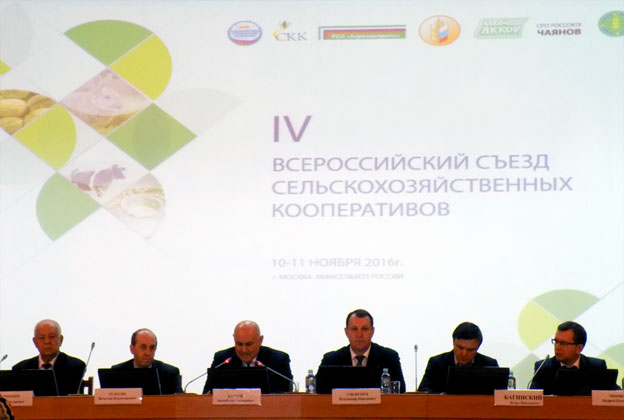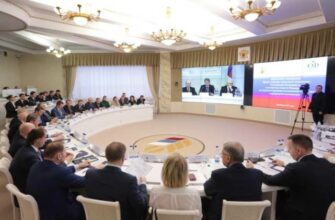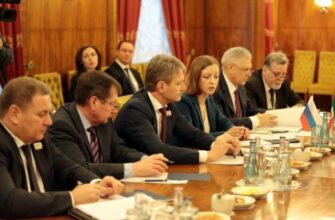IV all-Russian Congress of agricultural cooperatives was held on November 10, 2016 at the Ministry of agriculture of the Russian Federation, discussing how it is possible to achieve efficiency of agro-industrial complex with the use of agricultural cooperatives.
The topic of agricultural cooperation has a long tradition that dates back to communal times, and continues with more advanced technological solutions (one of them – the Stolypin reforms, the others are the farm of the NEP and Soviet collective farms). Solutions implemented in practice and the legislation of modern Russia since 1994 (the law “On agricultural cooperation”) is based on the idea of co-operative movement F. V. Raiffeisen, the Austrian mayor and founder of the “cooperative credit Union” (1846), which allowed the Austrian farmers to join savings and efforts to obtain loans with low interest rates and so to withstand the competition.
The results of national Agricultural census of 2016 in Russia are following:
- 18 million private farms (LPH) 2.8 million commodity LPH;
- 174’000 peasant farmer farms (KFKH);
- 36’000 agricultural organizations.
Agricultural cooperation is one of the forms of organization selfhosted, along with large forms (agricultural holdings) and other small and medium-sized businesses. Large farms give more economical efficiency, but small forms are necessary for country’s development and stability. “The challenge is to find ways for the development of agriculture, which would develop the small and medium forms of entrepreneurship, and. at the same time, would preserve the advantages of farming on a large scale,” – says an expert of sector V. F. Vershinin.
A member of an agricultural cooperative is owner, investor and client of the cooperative at the same time. He is obliged to take part in its activities, such as members of a processing cooperative is obliged to deliver products for processing, to buy processed products and to pay membership fees / make units
Deputy Minister of agriculture D. Hatuov said that: “Agri cooperation is one of the main instruments for ensuring food security”, and the Minister of agriculture Alexander Tkachev instructed the regions to create at least 1’500 agricultural cooperatives for the half year in 2016-2017. The question was how to develop a “road map” of the industry to convey to the Ministry wishes to develop.
According to Rosstat, on January 1, 2016 in Russia, there were 8’313 agricultural production cooperatives (CAS), 6’293 agricultural consumer cooperatives (ACC), of which 55% are working (3’491 PCs).
Currently cooperatives system includes 10% of agricultural enterprises or corporate farms (3’600 PCs), 2% peasant farms or KFKH (3’500 PCs), 1% private farms or household plots (1.7 million people). Depending on the primary activity of the cooperative it may be consumer, supply, credit, etc. Structure of cooperatives: processing – 16%; services 11%; supply and marketing – 24%; credit 25%; other – 24%.
Plan-task of the government in 2016-2017 is 1 500 cooperatives: processing 450 PCs (30%); serving – 75 (5%); supply and marketing – 900 (60%); credit – 75 (5%).
For its implementation it is planned to involve an administrative resource and financial support to the industry. “In 2017, the regions will have greater autonomy to each of the ruble,” – said D. Hatuov. Also, he said, “the country has created a logistics network that is associated with the promotion of agricultural products”. As for the qualitative component, the government would like to see export-oriented cooperatives and to develop mechanisms for replication of best regional practices.
The government has allocated grants to support beginning farmers (NF) and family farms (FSV). In 2016, the grants received 3’634 833 NF and FSV. In 2017 it is planned to allocate 5’651 grant for NF and 1’599 for FSV. The average grant size this year was 8.1 million rubles, in 2017 it will be 9.0 million rubles.
Among the additional measures of state support of cooperatives should be highlighted:
- the Ministry of agriculture is subsidizing the interest rates, reimbursement of the capital expenditure, sectoral subsidies to PCs (1 litre milk per 1 ha, breeding work)
- the Ministry of economic development – guarantee/surety, microfinance, entrepreneurs support centers, regional leasing companies, agro-industrial parks for General use.
Nevertheless, as of November 1, 2016 105 cooperatives were created only. To date, despite the support, the number of production cooperatives in comparison with 2011 fell by -31.8%, and consumer goods by -32.9%. V. Vershinin suggests that in Europe cooperatives “occupy a dominant position in the distribution system (79-100% of the sales of milk). In Russia, despite the considerable number (more than 4’000 cooperatives), they are weak. One of the levers of influence on cooperatives may be a tax system similar to the European, but also many other legislative and administrative solutions.
The Ministry of agriculture explains the decrease in the number of cooperatives inadequate legislation, lack of government support, lack of incentives and mutual trust, which prevents the unification. It all sounds reasonable.
From time to time in response to the performance of the speakers market participants laughed, making clear that the declaration is different from practice.
Maybe there are more important reasons why the practice of Western European societies have traditionally failed to take root in Russia? Raiffeisen was very close to the traditions of his people, and he limited the cooperative item by parish. Perhaps the regulation of business transactions, clearly spelled out in the cooperatives, is abhorrent to freedom-loving soul of the Russian peasant, and he feels that this is the same collective? The main thing that they started again, a century later, to drive by force.
Sources: Vershinin, V. F. Organizational and legal framework of agricultural cooperation. – M., Vershinin, V. F., 2016. Russian Ministry of Agriculture, Russian State Statistics Rosstat




